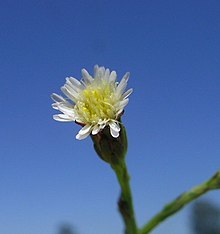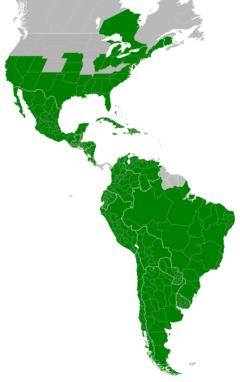Symphyotrichum subulatum (formerly Aster subulatus), commonly known as eastern annual saltmarsh aster or, in Britain and Ireland where it is naturalized, annual saltmarsh aster,[7] is an annual plant in the family Asteraceae native to the eastern United States and the Gulf Coast to Texas.[8] The species grows primarily in coastal salt marshes, although in the Ozarks it occurs as a non-marine weedy variety.[9]
| Symphyotrichum subulatum | |
|---|---|

| |
| Symphyotrichum subulatum var. subulatum | |
| Scientific classification | |
| Kingdom: | Plantae |
| Clade: | Tracheophytes |
| Clade: | Angiosperms |
| Clade: | Eudicots |
| Clade: | Asterids |
| Order: | Asterales |
| Family: | Asteraceae |
| Tribe: | Astereae |
| Subtribe: | Symphyotrichinae |
| Genus: | Symphyotrichum |
| Subgenus: | Symphyotrichum subg. Astropolium |
| Species: | S. subulatum
|
| Binomial name | |
| Symphyotrichum subulatum | |
| Varieties[3] | |
| |

| |
| Combined native distribution[3] | |
| Synonyms[3] | |
|
Basionym
Synonyms of varieties var. subulatum[4]
var. elongatum[5] var. squamatum[6]
| |
Description
editSymphyotrichum subulatum is an annual forb that possesses a single erect stem that can reach up to 1 meter (3 feet 3 inches) in height. The stem, along with its thin green to dark green leaves, are both hairless. The sheathing base-blades of the leaves are ovulate, and the margins are entire.[10]
The top of the stem extends into a raceme inflorescence. The heads open up into bright yellow disc florets that are surrounded by ray florets that vary in color from white to lavender.[11]
-
S. subulatum
-
S. subulatum base
-
S. subulatum stem and leaves
Taxonomy
editThe species' full scientific name is Symphyotrichum subulatum (Michx.) G.L.Nesom. As of December 2021[update], three varieties of S. subulatum were accepted by Plants of the World Online (POWO), with S. subulatum var. subulatum as the autonym:[3]
- S. subulatum var. subulatum[4]
- S. subulatum var. elongatum (Boss. ex A.G.Jones & Lowry) S.D.Sundb.[5]
- S. subulatum var. squamatum (Spreng.) S.D.Sundb.[6]
The varieties S. subulatum var. ligulatum (Shinners) S.D.Sundb. and S. s. var. parviflorum (Nees) S.D.Sundb., as of December 2021[update], are accepted at the species level by POWO as Symphyotrichum divaricatum (Nutt.) G.L.Nesom[12] and Symphyotrichum expansum (Poepp. ex Spreng.) G.L.Nesom,[13] respectively. As of December 2021[update], S. s. var. parviflorum (Nees) S.D.Sundb. is accepted at the species level by Catalogue of Life (COL) as Symphyotrichum parviflorum.[14]
Distribution and habitat
editSymphyotrichum subulatum is a terrestrial species that will typically grow among grasses of any kind.[10] It is found in salt marshes, pond margins, sloughs, swamps, crop field margins, lawns, and roadsides. It is thought to be especially prevalent in these areas because of a tolerance to saline soils and mowing.[15] It is native to the eastern and Gulf Coast areas of the United States. It is also common across Mexico, the West Indies, Bermuda, Central America, and South America, depending on variety.[11]
Uses
editAccording to the Lady Bird Johnson Wildflower Center, eastern annual saltmarsh aster can be planted to attract butterflies and has value for native bees.[16]
Citations
edit- ^ NatureServe 2021.
- ^ Maiz-Tome 2016.
- ^ Jump up to: a b c d e POWO 2021a.
- ^ Jump up to: a b POWO 2021d.
- ^ Jump up to: a b POWO 2021e.
- ^ Jump up to: a b POWO 2021f.
- ^ BSBI 2007.
- ^ USDA 2021.
- ^ Gleason & Cronquist 1991.
- ^ Jump up to: a b Sharma, Bhattacharjee & Lakshminarasimhan 2012.
- ^ Jump up to: a b Brouillet et al. 2006.
- ^ POWO 2021b.
- ^ POWO 2021c.
- ^ Hassler 2021.
- ^ Missouri Native Plant Society 2018.
- ^ TWC Staff 2018.
References
edit- Brouillet, L.; Semple, J.C.; Allen, G.A.; Chambers, K.L.; Sundberg, S.D. (2006). "Symphyotrichum subulatum". In Flora of North America Editorial Committee (ed.). Flora of North America North of Mexico (FNA). Vol. 20. New York and Oxford: Oxford University Press. Retrieved 7 July 2021 – via eFloras.org, Missouri Botanical Garden, St. Louis, MO & Harvard University Herbaria, Cambridge, MA.
- BSBI List 2007 (xls). Botanical Society of Britain and Ireland. Archived from the original (xls) on 26 June 2015. Retrieved 17 October 2014.
- Gleason, H.; Cronquist, A. (1991). Manual of Vascular Plants of Northeastern United States and Adjacent Canada. Bronx, New York: New York Botanical Garden. p. 590. ISBN 0-89327-365-1.
- Hassler, M. (8 December 2021). "Symphyotrichum parviflorum (Nees) Greuter – World Plants: Synonymic Checklists of the Vascular Plants of the World". In Bánki, O.; Roskov, Y.; Döring, M.; Ower, G.; Vandepitte, L.; Remsen, D.; Hobern, D.; Schalk, P.; DeWalt, R.E.; Keping, M.; Miller, J.; Orrell, T.; Aalbu, R.; Adlard, R.; Adriaenssens, E.; Aedo, C.; Aescht, E.; Akkari, N.; Alonso-Zarazaga, M.A.; et al. (eds.). Species 2000 & ITIS Catalogue of Life, 18 December 2021. Leiden, Netherlands: Naturalis Biodiversity Center. ISSN 2405-8858. Retrieved 30 December 2021.
- Maiz-Tome, L. (2016). "Aster subulatus". IUCN Red List of Threatened Species. Gland, Switzerland: International Union for Conservation of Nature and Natural Resources (IUCN). doi:10.2305/IUCN.UK.2016-1.RLTS.T19035773A78457022.en. ISSN 2307-8235. Retrieved 7 July 2021.
- Missouri Native Plant Society (19 November 2018). "Symphyotrichum subulatum (Michx.) G.L.Nesom — Inland Saltmarsh Aster". Retrieved 17 July 2021.
- NatureServe (2 July 2021). "Symphyotrichum subulatum Annual Saltmarsh Aster". NatureServe Explorer (explorer.natureserve.org). Arlington, Virginia. Retrieved 7 July 2021.
- POWO (2021a). "Symphyotrichum subulatum (Michx.) G.L.Nesom". Plants of the World Online. Royal Botanic Gardens, Kew. Retrieved 30 December 2021.
- POWO (2021b). "Symphyotrichum divaricatum (Nutt.) G.L.Nesom". Plants of the World Online. Royal Botanic Gardens, Kew. Retrieved 30 December 2021.
- POWO (2021c). "Symphyotrichum expansum (Poepp. ex Spreng.) G.L.Nesom". Plants of the World Online. Royal Botanic Gardens, Kew. Retrieved 30 December 2021.
- POWO (2021d). "Symphyotrichum subulatum var. subulatum". Plants of the World Online. Royal Botanic Gardens, Kew. Retrieved 30 December 2021.
- POWO (2021e). "Symphyotrichum subulatum var. elongatum (Boss. ex A.G.Jones & Lowry) S.D.Sundb". Plants of the World Online. Royal Botanic Gardens, Kew. Retrieved 30 December 2021.
- POWO (2021f). "Symphyotrichum subulatum var. squamatum (Spreng.) S.D.Sundb". Plants of the World Online. Royal Botanic Gardens, Kew. Retrieved 30 December 2021.
- Sharma, M.; Bhattacharjee, B.; Lakshminarasimhan, P. (December 2012). "Symphyotrichum subulatum (Asteraceae) — a first report of an alien weed in India". Nelumbo. 54 (December 2012). Salt Lake City, Kolkata: Botanical Survey of India: 252–254. doi:10.20324/nelumbo/v54/2012/57445. ISSN 0976-5069. Retrieved 7 July 2021.
- TWC Staff (19 September 2018). "Symphyotrichum subulatum". Lady Bird Johnson Wildflower Center (www.wildflower.org). University of Texas at Austin. Retrieved 7 July 2021.
- NRCS (2021). "Symphyotrichum subulatum". PLANTS Database. United States Department of Agriculture (USDA). Retrieved 30 December 2021.

